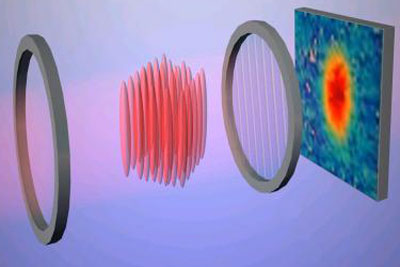Home > Press > Researchers find way for superconductivity and magnetism to coexist
 |
| Schematic showing an array of tubes containing lithium atoms. The system is probed by imaging the shadow cast by this ensemble. Nature Supplementary Information |
Abstract:
Dogs and cats, Harry Potter and Voldemort, superconductivity and magnetism -- they tend not to coexist. Superconductivity, the flow of electrons without resistance, is typically suppressed by magnetic fields, which disrupt the intricately choreographed electron motion.
By Anne Ju
Researchers find way for superconductivity and magnetism to coexist
Ithaca, NY | Posted on October 7th, 2010Theoretical physicists at Cornell, working with experimental physicists at Rice University, have carefully engineered a system in which these conflicting properties are believed to put aside their differences.
Publishing online Sept. 30 in the journal Nature, the researchers made and tested an ultra-thin, ultra-cold analogue of a magnetic superconductor -- a sort of one-dimensional wire filled with lithium atoms.
The researchers placed the lithium atoms into bundles of narrow tubes, each of which was only one atom thick. In order to see superconducting properties, they cooled the tubes to about 10 nanokelvin (less than one-hundred-millionth of a degree above absolute zero).
Inside the tubes, the atoms could only bounce off each other in a straight line along the tube. This kinetic restriction stabilizes a "spin density wave" wherein the magnetism is periodically modulated along the tube, on an atomic scale. Superconductivity predominantly builds up in the regions where the magnetism is weakest.
The Cornell theory team, which included assistant professor Erich Mueller and graduate student Stefan Baur, analyzed the experimental data and produced microscopic models of the system. Their principal mathematical technique, the Bethe-Ansatz, was invented by Cornell physicist and Nobel laureate Hans Bethe in the 1930s. Mueller describes the technique as "one of Bethe's greatest legacies."
The work was supported by the Defense Advanced Research Projects Agency's Optical Lattice Emulator program, which seeks to understand and explore the quantum mechanical properties of materials through experiments on atomic clouds.
####
For more information, please click here
Contacts:
Media Contact:
Joe Schwartz
(607) 254-6235
Cornell Chronicle:
Anne Ju
(607) 255-9735
Copyright © Cornell University
If you have a comment, please Contact us.Issuers of news releases, not 7th Wave, Inc. or Nanotechnology Now, are solely responsible for the accuracy of the content.
| Related News Press |
News and information
![]() Researchers develop molecular qubits that communicate at telecom frequencies October 3rd, 2025
Researchers develop molecular qubits that communicate at telecom frequencies October 3rd, 2025
![]() Next-generation quantum communication October 3rd, 2025
Next-generation quantum communication October 3rd, 2025
![]() "Nanoreactor" cage uses visible light for catalytic and ultra-selective cross-cycloadditions October 3rd, 2025
"Nanoreactor" cage uses visible light for catalytic and ultra-selective cross-cycloadditions October 3rd, 2025
Possible Futures
![]() Spinel-type sulfide semiconductors to operate the next-generation LEDs and solar cells For solar-cell absorbers and green-LED source October 3rd, 2025
Spinel-type sulfide semiconductors to operate the next-generation LEDs and solar cells For solar-cell absorbers and green-LED source October 3rd, 2025
Academic/Education
![]() Rice University launches Rice Synthetic Biology Institute to improve lives January 12th, 2024
Rice University launches Rice Synthetic Biology Institute to improve lives January 12th, 2024
![]() Multi-institution, $4.6 million NSF grant to fund nanotechnology training September 9th, 2022
Multi-institution, $4.6 million NSF grant to fund nanotechnology training September 9th, 2022
Announcements
![]() Rice membrane extracts lithium from brines with greater speed, less waste October 3rd, 2025
Rice membrane extracts lithium from brines with greater speed, less waste October 3rd, 2025
![]() Researchers develop molecular qubits that communicate at telecom frequencies October 3rd, 2025
Researchers develop molecular qubits that communicate at telecom frequencies October 3rd, 2025
![]() Next-generation quantum communication October 3rd, 2025
Next-generation quantum communication October 3rd, 2025
![]() "Nanoreactor" cage uses visible light for catalytic and ultra-selective cross-cycloadditions October 3rd, 2025
"Nanoreactor" cage uses visible light for catalytic and ultra-selective cross-cycloadditions October 3rd, 2025
Quantum nanoscience
![]() ICFO researchers overcome long-standing bottleneck in single photon detection with twisted 2D materials August 8th, 2025
ICFO researchers overcome long-standing bottleneck in single photon detection with twisted 2D materials August 8th, 2025
![]() Programmable electron-induced color router array May 14th, 2025
Programmable electron-induced color router array May 14th, 2025
|
|
||
|
|
||
| The latest news from around the world, FREE | ||
|
|
||
|
|
||
| Premium Products | ||
|
|
||
|
Only the news you want to read!
Learn More |
||
|
|
||
|
Full-service, expert consulting
Learn More |
||
|
|
||








